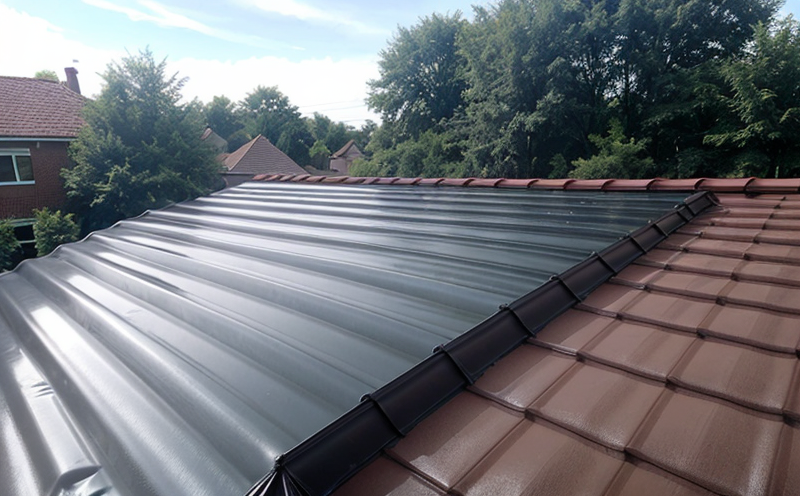EN 12310 Tear Strength of Roofing Sheets
The European Standard
The tear strength test measures how resistant a material is to tearing when subjected to a specific force applied at a defined angle. In the context of roofing sheets, this test evaluates the ability of the sheet to resist damage during installation or under harsh weather conditions such as high winds and heavy rainfalls.
Roofing materials are often exposed to extreme environmental conditions which can lead to premature deterioration if not selected appropriately. By adhering to EN 12310, manufacturers ensure their products meet rigorous quality standards, thereby enhancing the overall performance and lifespan of roofing systems in buildings.
The test method involves cutting a specimen from the roofing sheet according to specified dimensions provided by the standard. The cut specimen is then clamped into a testing machine that applies tension along with a defined angle until it tears. The force at which this occurs is recorded as the tear strength. This value provides valuable insights into the material's suitability for various applications.
For accurate results, careful attention must be paid to sample preparation and environmental conditions during testing. Ensuring samples are representative of the actual product being evaluated helps maintain consistency across different batches or variations within a single production run. Additionally, maintaining controlled temperatures and humidity levels ensures that any observed differences in performance can be attributed solely to intrinsic properties rather than external factors.
Understanding how EN 12310 applies specifically to roofing sheets allows us to appreciate its importance beyond just compliance with regulations. It serves as a tool for quality assurance teams who need reliable data about the materials they use, enabling informed decisions regarding material selection and product design improvements.
| Standard | EN 12310-1 & EN 12310-2 |
|---|---|
| Description | Tear strength test for roofing sheets |
Why It Matters
The integrity of a building's roof plays a crucial role in protecting the structure from water ingress and other environmental elements. A weak tear resistance can lead to leaks, which not only cause damage but also increase maintenance costs significantly over time. Ensuring compliance with EN 12310 helps prevent these issues by guaranteeing that roofing materials have sufficient strength against potential tearing forces.
Furthermore, selecting high-quality roofing sheets based on their tear strength ensures better energy efficiency as well as improved aesthetics of the building exterior. Stronger materials contribute to longer-lasting roofs, reducing the frequency of replacements and associated disruptions for occupants.
From a broader perspective, compliance with international standards like EN 12310 promotes fair competition among manufacturers by setting clear benchmarks. This fosters innovation while maintaining consistent quality levels across various markets globally.
In summary, understanding and implementing EN 12310 tear strength testing is essential for anyone involved in the building & infrastructure sector, especially those responsible for specifying or sourcing roofing materials.
Applied Standards
| Standard | Description |
|---|---|
| EN 12310-1 | Tear strength determination of flexible waterproofing membranes for bituminous products, mineral felt and similar materials. |
| EN 12310-2 | Tear strength determination of rigid waterproofing systems, including roofing sheets. |
The tear strength test described in these standards is applicable to both flexible and rigid waterproofing systems used in construction. It covers various types of materials commonly employed for roof covering such as bituminous products, mineral felt, synthetic membranes, etc., making it versatile enough to cater to different roofing needs.
For instance, when dealing with asphalt shingles or similar flexible roofing sheets, EN 12310-1 would be the appropriate standard. On the other hand, for more rigid materials like concrete roof tiles or metal panels, EN 12310-2 would apply. Both standards emphasize accurate measurement techniques and considerations that ensure reliable test results.
The key difference between these two parts lies in their focus areas – flexible vs rigid systems – but they share common goals: providing consistent methods for determining tear strength across various types of roofing materials. This ensures uniformity in quality assessment, facilitating better decision-making processes among professionals involved in the building & infrastructure industry.
Eurolab Advantages
At Eurolab, we pride ourselves on offering world-class testing services tailored specifically to meet the stringent requirements set forth by EN 12310. Our team of experienced professionals ensures that every aspect of your roofing project receives thorough analysis, from initial sample preparation through final reporting.
We employ state-of-the-art equipment calibrated according to international standards to guarantee precise measurements and repeatable results. With our comprehensive suite of facilities, we can accommodate a wide range of materials and sizes, accommodating even the most complex samples without compromising accuracy.
In addition to standard tear strength testing, Eurolab also offers additional services such as accelerated aging tests, weathering exposure trials, and full-scale mock-up installations. These supplementary tests provide valuable data that go beyond simple tear resistance measurements, giving you a complete picture of your roofing material's performance capabilities.
Our commitment extends beyond just meeting regulatory requirements; we work closely with our clients to understand their unique needs and challenges. By providing detailed reports accompanied by expert advice, we aim to help you make informed decisions that will ultimately lead to successful projects.





